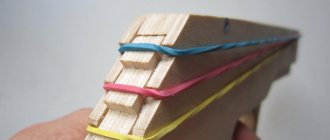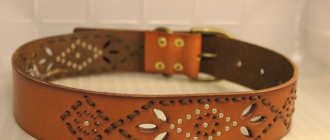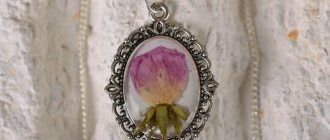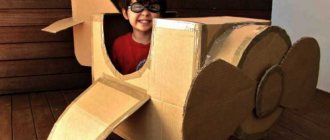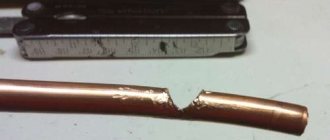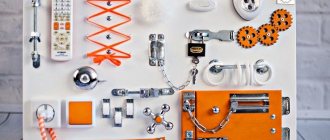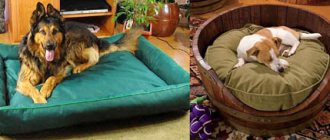Home » Building a house » Premises » Bedroom
Annie Cooper 01/21/2019
4666 Views
The bed is perhaps the most important piece of furniture in the apartment, intended for sleep and relaxation. However, it is not always possible to find the desired option in the assortment of finished products. Then you can make a sleeping place yourself, receiving several advantages at once: original author’s design and functionality at a low price. We will tell you further how to make a bed with your own hands and what materials to choose for this.
Design
Hanging bed - an unusual design solution in the bedroom interior
Any bed, regardless of shape and configuration, consists of the following components:
- Frame
- Base
- Side and support panels
- Optional design elements (legs, hanging backrests, headboard, storage drawers, lifting mechanism)
A home-made sleeping place usually consists of a frame on which a base is installed - a mattress support. The supporting structure is made from:
- wooden slats (slats)
- metal mesh
- spring mechanism
Furniture for sleeping and relaxation can:
- have legs (most often no more than 20 cm high)
- be floor-standing (the frame is located directly on the floor)
- be suspended (fixed to the ceiling)
Original headboard for bed
The headboard is a decorative element that:
- carved from wood
- sawn from chipboard
- forged from metal
- upholstered with foam rubber and fabric
- can be carved and solid, straight and curved
In addition to the main functionality - a place to rest, the bed also serves as:
- closet
- stand
- sofa
- podium
In these cases, the mattress is hidden in the shell of the body during the day, and at night it is unfolded using a “book” mechanism or a gas lift.
Legs
Making legs yourself is the easiest step in the entire construction process.
Whole production process:
- the prepared beam with a cross-section of 10x10 cm must be cut into 6 bars 10.5 cm long;
Preparing for future legs
- fastening is carried out to the support bars;
- for the strength of the frame, two additional legs are attached under the central support, at a distance of 50 cm from the edges of the frame;
- They can be given any shape for decoration. You can cut one of the corners at a distance of about 3 cm from the bottom, at an angle of 45 degrees, as in the photo;
- at the end of the work it is necessary to sand all sides.
Recording all created elements:
- as mentioned above, the legs are attached to the supporting boards of the frame. To do this, use 60 mm self-tapping screws. You need to spend at least two on each leg;
This is what the legs look like inside
- holes are pre-drilled with a drill, a drill whose diameter coincides with the cross-section of the screws.
The legs are attached to the frame
. Before screwing in screws, you should first drill holes, which will reduce the risk of splitting the boards.
Choice of frame material
For self-assembly of furniture, wooden models are most often chosen
For the body of sleeping furniture, reliable materials with high strength values are used:
- Tree . Natural, eco-friendly material, best suited for work. However, it is afraid of moisture and is susceptible to fire
- Metal (corners or pipes). Such furniture will be durable, will last a long time and will not creak. It is worth considering the large weight of the structure and the risk of corrosion. In addition, the strict cold design of metal is not suitable for every interior.
- Fiberboard or chipboard. Furniture is the most fragile and therefore unreliable.
- Rattan _ Durable, versatile material, but expensive. It is cheaper to buy a ready-made rattan product
- Pallets . Making a structure from them is reminiscent of assembling a construction set from identical parts. But pallets do not always fit into the traditional conservative style of an apartment
Requirements for a master
To make a bed, several conditions must be met, and all of them are equally important; the absence of at least one of them causes an unsatisfactory result. In this case, it is much better not to start work at all. What criteria must a home furniture maker meet?
- Have practical experience in carpentry work. Don’t flatter yourself with the thought that 2-3 articles read will make you a master; theory can never provide the knowledge and skills that can be acquired in practice. You must make independent decisions in difficult situations, feel the tool, not be afraid of woodworking machines, etc.
- Have tools and equipment. Do not think that the quality of handmade work is superior to the quality of mechanical processing. You will never be able to get the same smooth, clean, and smooth surfaces as with a four-sided router, circular saw, or sander. You must have a minimum list of woodworking equipment.
To make wooden furniture you need appropriate equipment
- Have a great desire and free time. Even experienced masters are sometimes disappointed, but you shouldn’t just tune in to a minor key. Prepare for problems, do not retreat when they arise, but analyze the reasons for their occurrence and make every effort to solve them.
- Have material resources. They are not so large, but for a good bed you need to purchase lumber of at least first grade, use only high-quality paints and varnishes.
High-quality lumber is not cheap
If you have positive answers to these questions, then you can start making the bed.
Bed dimensions
Drawing of a double bed
Depending on the parameters of the sleeping place, the beds are:
- Single . The optimal width for resting 1 person is 85–120 cm, length is no more than 2.2 m
- One and a half . Width – up to 1.6 m, minimum length – 1.9 m. Suitable for free sleep of 1 person or rest for a mother and a small child
- Double . From rectangular shapes - 1.6 m by 1.9 m to almost square - 2.3 m by 2.2 m. This design comfortably accommodates 2 people
Another option is bunk furniture, where 2 sleeping places are located one above the other on a metal frame. Most often they are used to equip children's rooms, where this is the only way to save space.
Preparatory work
Schematic drawing for assembly
Before deciding to assemble furniture yourself, experts advise determining the following parameters:
- Location of the structure in the room
- Number of people who will use it
- Availability of material for the manufacture of the frame and necessary accessories
- The ability to buy a ready-made mattress or the need to order a non-standard size option
- Availability of drawings and diagrams for manufacturing
Necessary materials
A level, tape measure and fasteners are needed to assemble any bed.
After selecting the frame material and calculating the dimensions of the future bed, purchase the necessary materials. For a wooden structure (fibreboard, chipboard, plywood, rattan) - this is glue, acrylic varnish, wood stain, painting brushes, sandpaper, putty.
To work with metal you will need the following tools:
- circular saw (grinder)
- metal drill set
- welding machine
- file
- brush for metal surfaces
Tools for making a bed
Any of these structures cannot be assembled without:
- measuring tape
- electric drill
- metal corners
- screwdriver
- self-tapping screws
- adjustable square
It is convenient to work with wood, having the following tool set:
- electric jigsaw (hacksaw)
- chisel
- plane
- Grinder
Fastenings
To assemble a high-quality, durable and strong bed, you need to prepare the following fasteners:
- Self-tapping screws. Their length is from 3 to 7 centimeters. Simple black items will do. They are of acceptable quality and low price. Decide for yourself how much to take, taking into account the plan and drawings of the bed.
- Nails. Length from 6 to 7 centimeters.
- Metal corners.
It is worth noting that any connections are made with sizing. Therefore, it is recommended to use phosphated screws. Their distinctive feature is their rough surface. The glue will adhere much worse to a smooth, shiny mount.
The choice of metal corners must also be taken seriously. The first criterion is stiffeners. It is important that they are round and wide. The second is the fold. Make sure that its surface is perfectly smooth before purchasing.
The presence of burrs indicates that low quality burnt metal was used to create the corners. Such fastenings are short-lived. The corners quickly crack and break.
Gluing is a process without which it is impossible to make a high-quality bed. Apply glue to each surface using a small notched trowel. The parts are held for four to ten minutes.
Hallways 2022: TOP-200 photos of the best new products and modern design. Options for the ideal combination of color and style of furniture in the hallway- DIY stool: manufacturing methods and instructions for creating simple and stylish models (90 photo ideas)
- Do-it-yourself door finishing: 115 photos of the best options for entrance and interior doors
Furniture Assembly Instructions
Pallet bed
When making a bed from different materials, the tools used and the procedure are different. Let's look at each case in more detail.
Made of wood
Double wooden furniture, assembled on your own, will decorate any interior
A balanced choice for a beginner in carpentry is to make a rectangular structure from solid wood.
Calculation of materials
Wooden blocks and boards - the main materials for making a bed - must be dry and of high quality
To make a double wooden bed with legs measuring 1.6x2 m you will need:
- 15 pieces of pine beams 220 cm long and 5 by 5 cm in section
- 22–24 planed 2-meter boards, 10 cm wide, at least 2 cm thick
- Glue
- Self-tapping screws (0.4 cm and 0.6 cm)
- Metal corners of suitable size
Step by Step Actions
Ready to assemble bed frame parts
Next, the work is performed step by step according to the following instructions:
1 Using wood glue, glue together 4 wooden blocks with a length of 220 cm (2 parts), 160 cm (2 parts), 210 cm (1 part). The result is 5 blanks of different sizes, but the same thickness of 20 cm
2 Fold the paired blanks into a rectangle and fasten the joints with glue. Corners overlap for strength
The joints of the parts are reinforced with metal corners
3 A single crossbar is attached to an inverted frame along exactly the middle. The lamellas are subsequently attached to it. Strengthen the jumper with persistent 15-centimeter bars or metal corners
4 Additionally, the parts are fastened with self-tapping screws. At this stage, it is important to ensure that the proportions of the structure are maintained and the right angles inside
The legs are attached with self-tapping screws to the corners of the frame
5 The legs are screwed into the corners of the frame - they are the remains of the same pine beam with a length of 20–30 cm or higher (optional). Attach the supports to the inverted frame with glue, self-tapping screws, and reinforce them on both sides with corners
6 The block in the middle of the wooden blank is also placed on 2 legs on top and bottom to give the structure additional stability and prevent the center from sagging
The slats are laid perpendicular to the side and central panels
7 The body is turned over. Support boards or remnants of timber are installed at the same level as the central crossbar. Lamels are placed transversely on top of them at a distance of 4–5 cm from each other.
8 It is important that the boards laid crosswise do not rest against the sides of the frame - this will cause the structure to creak during use. Provide a gap of at least 0.5 cm on each side
9 The slats are screwed to the side and central panels with two 4 cm screws so that the base is rigid and can withstand the weight of the mattress and people
10 Check the correct installation, the stability of the frame, sand all wooden elements with a machine or sandpaper
Finished piece of furniture covered with stain
11 The finished product is coated with a primer or stain, and then varnish
12 From the remaining boards they knock down a headboard, which is attached not to the frame, but to the wall above the bed
How to make a double bed with your own hands using a tool
How to make a bed with your own hands: step-by-step instructions for assembling designer furniture | 60+ Photos & Videos
Made of metal
Scheme for welding metal profiles with a reinforced grid at the base
It is difficult for a beginner to make metal furniture without the skills of welding and cutting metal, however, with minimal experience, it is possible. Experts do not recommend assembling parts with bolts - the structure will quickly become loose.
When working on a bunk metal bed, profile pipes are used:
- 2 by 2 cm (from 40 m and more)
- 4 by 4 cm (minimum 8 m)
- 5 by 2.5 cm (8–10 m)
Bunk beds are best for children's rooms
When working, they start by making the backs from 4x4 cm pipes, the shelves are made from a 5x2.5 cm profile, and the lintels are made from 2x2 cm pipes. The order of welding the parts is determined by a pre-drawn diagram, the collapsible parts are connected with self-tapping screws.
DIY metal bed
How to make a bed with your own hands: step-by-step instructions for assembling designer furniture | 60+ Photos & Videos
From laminated chipboard or plywood
Thanks to the drawers, the bed turns into a storage system
When assembling a bed from laminated chipboard, you need to take into account the peculiarity of the material: the sheets are difficult to cut and sand at home. Therefore, the easiest way is to order the necessary parts in a carpentry workshop and work with them in the future.
For a single bed with functional drawers, you only need 1 sheet of laminated chipboard. It is cut into 17 parts of given sizes, from which the frame, supports of the bed itself and drawers are then assembled.
When working with slabs, the same tools are used as with wood . Additionally, you will need European confirmed screws and plugs for them, plastic rollers and handles.
The assembly procedure is as follows:
- Drawers are assembled from finished parts, connecting to each other with confirmations. Experts advise using a drill with a special confirmatory drill. Plastic or polymer rollers are glued to the bottom for movement, and a handle is screwed to the side panel
- In the same way, the lower bed frame is assembled from 3 parts - one side remains open - there will be drawers. 4 plastic legs are nailed to the corners
- The upper part - the decorative box - is made rectangular and installed so that it does not interfere with sliding the drawers
- Plywood slats are attached transversely to the frame at a distance of 10 cm from each other. For fastening, use self-tapping screws 3 cm long
- Place a mattress on the base and roll the boxes inside
A single bed does not require an additional crossbar, but when making double furniture this element is provided.
The round shape of the bed suggests a frame of non-standard shape
If the choice is made in favor of a round-shaped bed and mattress, then a sheet of plywood is used for the work - it is stronger than laminated chipboard and easier to cut. In this case, the frame is attached crosswise, and wooden beams are attached to the sides of the cross. The front part of such furniture is decorated with hardboard.
From pallets
Assembling a bed from pallets is the simplest and most inexpensive option for arranging a bed
The easiest way to make a piece of furniture with your own hands quickly and without high costs is to use wooden pallets. For each bed you will need 2 structures (with legs) or 4 elements (without legs).
The pallets are sanded, coated with primer, painted with acrylic paint in 2-3 layers, and varnished. The workpieces are connected to each other with self-tapping screws, the first layer to the second - with metal plates. A headboard is made from the remains, a mattress is placed on the frame and the bed is used for its intended purpose.
Wood preparation
Before starting work, the wood must be cut to size, the ends and corners sanded, and possible defects and irregularities removed. This point should not be neglected, because otherwise wooden beds will look like an awkward home product.
The procedure is as follows:
- Cut all the bars and boards according to preliminary markings. Sand the cut areas, clean the corners and the entire surface to make it smooth.
- Treat all structural elements with a wood primer before assembly so that there is protection even in hard-to-reach places and fasteners.
- Impregnations and pigments for wood are used if it is necessary to enhance the structure of the fibers. They prevent rotting processes, strengthen the base and increase the service life of the finished product.
- If smoothness and uniformity are important, it is better to use stains. They should be applied in two layers with a brush or nap roller before final installation of the entire structure.
- Varnishing is carried out at the final stage of installation. Be sure to wait a while for the surface to gain strength and for the unpleasant odor to disappear; Furniture can only be used after its final demise.
To prevent the bed from creaking, when assembling the frame and installing other structural elements, the joints must be treated with wood glue, which will strengthen the fastening and provide the necessary “layer.” If this is not done, squeaking cannot be avoided.
Wood processing
Primer
Wood impregnation
Applying paint
Varnished
Making a wardrobe bed
Drawing for making a wardrobe-bed
When assembling a structure that serves as a closet during the day and a sleeping place at night, the following nuances are taken into account:
- It is recommended to use an old finished frame without longitudinal crossbars and slats.
- The corners of the frame base are attached to a vertical surface (concrete or brick wall)
- 2 lifting mechanisms and 2 gas springs are attached to the sides of the structure
- The bed frame, made using wood or chipboard technology, is firmly bolted to the lifts
- It is important to correctly adjust the mechanism so that the berth rises and falls without distortions and jumps, and gently fits into the grooves of the frame
- Additional shelves and narrow cabinets are installed on the sides of the cabinet body. It is recommended to use this design not as a main bed, but as a guest bed.
A homemade bed is an unusual interior and design solution that emphasizes the individuality and creative inclinations of the homeowners. Having drawings and minimal carpentry skills, making bedroom furniture is simple and much more profitable than buying it.
A sleeping place created with your own hands according to the given recommendations will be reliable and durable, providing comfortable sleep and rest.
Wardrobe-bed with a lifting mechanism in the interior
Pros and cons of lifting mechanisms
Storing frequently used items under a mattress lift is not always the best solution.
- Lifting the mattress system every day is quite difficult. You have to first clean the bed and then make it again.
- Not all mechanisms can compensate for the heavy weight of the structure; significant physical effort must be made to lift the bed. There is an option to make this process much easier, but for unknown reasons, no factory model uses it. Below in this article we will tell you how to do this yourself.
- A lot of dust collects under the mattress; all things and bedding stored under the bed must be carefully covered to protect it from contamination.
- The bedding completely covers the ventilation holes of the space under the mattress. In a closed space, natural ventilation cannot function - the parameters of relative air humidity increase. Negative consequences apply to things and all bed designs.
When filling the space under the mattress, the natural ventilation of the bed is disrupted
The listed problems are disadvantages of a bed with a lifting mechanism. But everything is not so bad, check out the advantages of the design.
- Versatility. The bed is used for its intended purpose and at the same time replaces a large chest of drawers for storing various items. In it you can store bedding, seasonal clothes and shoes, rarely used items, tools, etc. Most housewives have a certain number of things that they don’t want to throw away and don’t want to wear. They must first lie down, and only after that a decision is made about their future fate.
- Possibility of using the most modern technical advances. If previously only springs had mechanisms to facilitate lifting, today the entire process can be controlled remotely using an infrared portable remote control.
The lifting mechanism can be controlled remotely
All that remains is to objectively weigh all the advantages and disadvantages and only after a careful analysis of the factors make a final decision.
